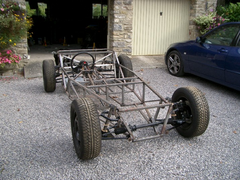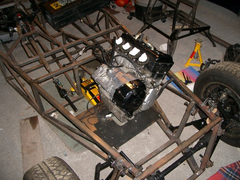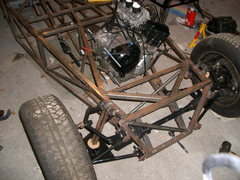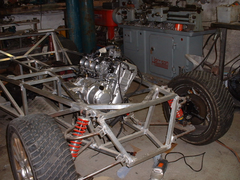
Has anyone completed a R1 engine 7?
Gremlin - 15/10/03 at 01:54 PM
I started to build a car about 12 months ago and intended to put a
Zetec engine in it but over the year one thing lead to another and i
now have a nice R1 Engine with all ancillaries sat in my garage.
I am now a little stumped! If anyone has any info on building a R1
engined car can they let me know for example;
Where to get exhaust?
How to setup clutch?
How to setup Gear change
What is the best gearing for a diff if i want to use irs?
How to connect the engine to the drive shaft?
Do i need to over fill with oil or put baffles in the sump?
Do i need disks on the back if so do i need duel master cylinders?
Anything like that would be really grateful as you can see im a
little stumped and wasn't expecting initially to go this way so all
my research is on CEC not BEC.
Thanks in advance
Mike
KennyC - 15/10/03 at 02:01 PM
try this site - not a loco - but very good !
www.striker1.plus.com/
Gremlin - 15/10/03 at 03:42 PM
Yeah looked at this site and it is very good. But he does loads to the engine before he even puts it into the car and wondered if this is necessary or
whether being a newbie and first BEC it would be best to swap or sell the engine and get a blade instead although i know they arnt as powerful.
Any help would be good as im very confused and want to make this build as easy as possible as a first time.
ned - 15/10/03 at 04:04 PM
have you checked on the yahoo bec list, i've heard there are some r1 people on there...
Ned.
Gremlin - 15/10/03 at 04:08 PM
Yeah just been there very helpful so not so panicky now.
Plus found out ST do some of the bits i was worried about sourcing.
Bob C - 17/10/03 at 09:43 AM
I'm doing the same.
Most towns have exhaust fabricator (varying quality levels). so I'll try to get a copy of the "strikerR1" exhaust made, probably at JP
in Macclesfield
I got myself a lathe from loot to do the drivetrain bits. This was a real bargain - like you don't find on ebay aby more...
My main concern is the IRS but I've got my brother (structural engineer) interested & he's building a solid model for me that looks
really good (ie actually got some triangles in there!).
I'm going for a very high ratio diff 3.14:1 gives similar ratios to the bike so any motorway work won't be as frantic.
BTW I'm aiming for mazda mx5 uprights - these are now cheap as chips (common as muck..) modern light reliable no adjustment necessary - anyone
else tried these?
Bob C
kingr - 17/10/03 at 02:53 PM
I'm building an R1 locost IRS, not finished by any stretch. It's nice to see other people doing the same thing. To answer your questions :
1. Already been answered to an extent, and there tones of detail on the (fantastic) R1 striker site. I'm going to be custom fabricating my own SS
exhaust - I've got to justify my shiny new HF tig somehow!
2. You'll need a lot less clutch movement than on a conventional gearbox, around 15mm from memory, you definately don't want to over extend
the clutch or it can get stuck open (also on striker site). I'm also custom making my pedals, so I'm going for a reasonably low ratio (if
you make it too low, the travel required will be absolutely tiny, and modulation will go out of the window) and probably an additional spring to add
some weight.
3. Gear change, two options, cable or solid, cable uses either one or two cables running from the shift lever to the gearbox, solid uses bars/tubes
and bellcranks to translate the movement of the lever into something suitable for the gearbox. I'm going for solid, other have used cable,
it's just down to what takes your fancy really.
4. Gearing you can calculate, but there are lots of different factor involved : gearing of gearbox (different bikes have different gearings), diff
ratio, wheel rim size, tyre profile and finally, what sort of driving you want to do and hence what top speed/acceleration you want.
5. There are a few different variations but basically, you need an adapter to connect the gearbox to the prop, and then either two short props and a
reverse box, or one long prop made of two parts with a centre bearing. Reverse boxes are not generally over reliable, and they're also extremely
expensive, so I'm not going to bother.
6. There's lots of different things you can do with oil, the striker R1 website covers a very good solution, so I'll let you get the info
from there.
7. You don't have to use disks, there's many many BECs out there that don't have disks (virtually all the live axle ones for starters)
Jon Isons and Jaspers to name just two. Front brakes are a lot more important, and it's them that are worth spending time and money on.
Cortina/sierra front discs don't tend to get too many complaints about their braking performance anyway, it's more weight that is the issue.
I'm using rear discs, but that more due to them being standard on Sierra 4x4s which have LSDs (if drum braked LSD rear ends exist at all,
they're very rare), and the fact that I'm a tart, and don't want drum brakes behind my alloys.
Personally, I'd stick with your R1, it's more powerful, probably newer, and it's unlikely to be much more complicated than any other
bike engine you care to use. The only part that is going to be more difficult is emissions.
Anyway, here's a couple of pictures of my progress.
Kingr


Rescued attachment IMGP0049small.JPG
kingr - 17/10/03 at 02:53 PM
and another


Rescued attachment IMGP0063small.JPG
ChrisGamlin - 17/10/03 at 03:33 PM
Kingr, are you planning on putting any more tubes in around the front suspension area?
kingr - 17/10/03 at 04:30 PM
Yup, I'll have the 3 normal tubes around the top of the engine bay, and possible a little more triangualtion, nothing too mental though, I
don't want to cause myself unnecessary woes later on when routing water pipes and the steering extension and I also don't want to add too
much additional weight. I'd left them out until I had the engine and had worked out how I was going to mount the engine. Funny enough I'm
plannning on doing it over the weekend. Do you have any additional recomended tubes?
Kingr
Gremlin - 17/10/03 at 04:49 PM
Thanks for the help kingr. At the moment your car is almost finished compared to mine.
I have an engine and am just about to try to fit the windage plate. That will be fun drilling holes into the perfectly formed crank case.!
Fly by the seat of the pants part.

ChrisGamlin - 17/10/03 at 08:30 PM
Rather than try and explain which ones I would put in, Ive drawn on your original picture. 

The red ones I assume you are putting in anyway, the 3 yellow ones are ones that I have added on my chassis. The front suspension pickups need to be
stiff, and when building my car I remember reading about someone analysing the standard design and saying that diagnonals in this area significantly
improved things (which is what Westfield have also done with the Mega chassis).
Also, with a BEC engine where you have no gearbox passing up the tunnel, you can usually get away with leaving the tube running across the bottom of
the footwells intact, so it runs right the way across the chassis to stiffen up the tunnel and footwell area.
My chassis (an MK live axled chassis) originally had this tube chopped out too, so rather than replace the entire tube, I just got a length of
3/4" tube, slid it up inside the ends of the 1" tubes, and welded it all together.
HTH
Chris
ChrisGamlin - 17/10/03 at 08:43 PM
Just thought of one other tube Ive put in which is pretty important. The steering rack mounts as you have them (and as I had them) are pretty crap.
Once fully built and on the ground, when wiggling the steering from side to side, I could see the mounts flexing side to side! Ive now put in a
diagonal on to those too which has stopped the movement quite succesfully.
kingr - 13/12/03 at 04:58 PM
Just thought I'd give a quick update - it's been done for some time, but I've just been to lazy to put the photos on the computer. So
here's how it looks, I added all the recomended tubes plus one other which I think should improve things further.
Kingr


engine bay
JoelP - 13/12/03 at 05:29 PM
nice. have you shortened the engine bay there or is that how they all are?
kingr - 14/12/03 at 12:33 AM
Joel, it's a standard book size chassis apart from the rear end (which is Tiger IRS), so the engine bay is normal - what will make it look
shorter though is the extra tube across the front. I didn't like to put a diagonal in which only made a triangle with one side, so I had a choice
of either putting another diagonal in the opposite direction, or put that tube in. There aren't really any packaging constrains with a bike
engine (you don't have to pull the engine up and forwards like a normal car engine) so I went for the one that was easier and used less steel.
Doing double diagonals would a) have made it look like a Caterham (make of that what you will) b) given a little more room to get a normal engine out
c) possibly looked a little flashier and d) taken an eternity to do without a notcher.
Kingr
deneo - 16/12/03 at 10:41 PM


Rescued attachment DSCF0012.JPG
Digger Barnes - 17/12/03 at 08:35 AM
I am just starting a build on a blade engine bec. This thread brings up a question.
It looks like the transmission tunnel is as book on these photos. Is it possible to reduce the width?.
I ask this as I have size 12 feet and an extra couple of inches near the pedals would be a great help.
kingr - 17/12/03 at 10:34 AM
Digger,
With an R1 - yes, quite probably, although bear in mind that you need to run the prop and the gear shift down it, and it could get pretty cramped.
With a Fireblade, I suspect not - the R1 uses a stacked gearbox that brings the output closer to centre of the car, whereas as far as I know the
Fireblade has a regular gearbox which pushes the output over toward the driver's side.
I could be wrong though.
Kingr
Digger Barnes - 17/12/03 at 12:47 PM
Cheers
mmm I shal have to sit the engine on the chasis base tonight to get a better idea.
ChrisGamlin - 17/12/03 at 02:41 PM
I think you'll struggle to make it much narrower on the drivers side as KingR says. Mine's a book chassis with blade and the prop probably
runs within about an inch of the drivers side tunnel, and the engine cant go over any further without it hitting the chassis rail above the
exhaust.
One way that might help is to shorten the passenger footwell and mount the engine further back in the chassis, as done on quite a few racing BECs.
This has the knock on effect of allowing the engine to sit further across to the passenger side as the side chassis rail (the restriction) is
obviously angled so further back you go, the further over you can mount it.
[Edited on 17/12/03 by ChrisGamlin]
kingr - 17/12/03 at 02:57 PM
One thing to bear in mind if you're planning on moving the engine into the passenger footwell is that bike engined 7s tend to have a rear weight
bias anyway, and moving the engine back will increase that with the expected results in handling (ie. more snappy rear end on the limit, probably more
traction though).
I've got a photo at home taken down my tranny tunnel which shows what a difference the stacked gearbox makes - the output sprocket is almost
exactly in the centre of the car.
Kingr
Digger Barnes - 17/12/03 at 04:15 PM
Interesting I shall have look into that as my aim is to build with the intention of possibly racing in RGB cat C.
Some more thought required me thinks.
ChrisGamlin - 17/12/03 at 05:48 PM
quote:
Originally posted by kingr
One thing to bear in mind if you're planning on moving the engine into the passenger footwell is that bike engined 7s tend to have a rear weight
bias anyway, and moving the engine back will increase that with the expected results in handling (ie. more snappy rear end on the limit, probably more
traction though).
I've got a photo at home taken down my tranny tunnel which shows what a difference the stacked gearbox makes - the output sprocket is almost
exactly in the centre of the car.
Kingr
Yep I agree, it doesnt really make too much sense to me either as a BEC generally has a rear bias already as you say, but doesnt seem to harm the RGB
racers.
Chris






